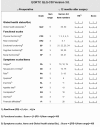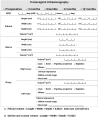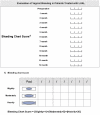A randomized prospective trial of the postoperative quality of life between laparoscopic uterine artery ligation and laparoscopy-assisted vaginal hysterectomy for the treatment of symptomatic uterine fibroids: clinical trial design
- PMID: 19178748
- PMCID: PMC2645389
- DOI: 10.1186/1745-6215-10-8
A randomized prospective trial of the postoperative quality of life between laparoscopic uterine artery ligation and laparoscopy-assisted vaginal hysterectomy for the treatment of symptomatic uterine fibroids: clinical trial design
Abstract
Background: Laparoscopy-assisted vaginal hysterectomy is one of the definite methods for the treatment of symptomatic uterine fibroids with lesser intraoperative bleeding and shorter hospitalization compared with abdominal hysterectomy. However, laparoscopy-assisted vaginal hysterectomy cannot preserve uterus and can show postoperative complications by the change of pelvic structure. Thus, laparoscopic uterine artery ligation has been introduced for relieving the symptoms caused by uterine fibroids in place of hysterectomy. The current study was designed to compare postoperative quality of life between laparoscopic uterine artery ligation and laparoscopy-assisted vaginal hysterectomy, and to evaluate the efficacy of laparoscopic uterine artery ligation which can treat symptomatic uterine fibroids with the preservation of uterus.
Methods and design: Patients enrolled the current study are randomized to laparoscopic uterine artery ligation or laparoscopy-assisted vaginal hysterectomy. The primary outcome is to compare postoperative quality of life between laparoscopic uterine artery ligation and laparoscopy-assisted vaginal hysterectomy using the European Organization for Research and Treatment of Cancer Quality of Life Questionnaire for Cancer patients version 3.0. Secondary outcomes are to evaluate the volume reduction of uterus, uterine fibroids and ovaries by the 2 treatments, to compare the improvement of subjective symptoms using 11-point symptom score and postoperative clinical outcomes between laparoscopic uterine artery ligation and laparoscopy-assisted vaginal hysterectomy, and to investigate the improvement of postoperative vaginal bleeding by laparoscopic uterine artery ligation.
Discussion: Among treatment methods for symptomatic uterine fibroids with the preservation of uterus, laparoscopic uterine artery ligation is expected to have the efficacy like uterine artery embolization, which appeared to be safe for routine use with symptomatic relief. The current study fully recruited in June 2008 and the results will be available in June 2009. If there is no difference of postoperative QOL between laparoscopic uterine artery ligation and laparoscopy-assisted vaginal hysterectomy for the treatment of symptomatic uterine fibroids, the comparison of quality of life between laparoscopic uterine artery ligation and uterine artery embolization will be also needed as a surgical treatment for preserving uterus.
Trial registration: Current Controlled Trials ISRCTN76790866.
Figures




Similar articles
-
Long-term health-related quality of life and symptom severity following hysterectomy, myomectomy, or uterine artery embolization for the treatment of symptomatic uterine fibroids.Am J Obstet Gynecol. 2023 Sep;229(3):275.e1-275.e17. doi: 10.1016/j.ajog.2023.05.020. Epub 2023 May 26. Am J Obstet Gynecol. 2023. PMID: 37244458
-
The management of uterine leiomyomas.J Obstet Gynaecol Can. 2003 May;25(5):396-418; quiz 419-22. J Obstet Gynaecol Can. 2003. PMID: 12738981
-
Laparoscopic-assisted vaginal hysterectomy with uterine artery ligation through retrograde umbilical ligament tracking.J Minim Invasive Gynecol. 2005 Jul-Aug;12(4):336-42. doi: 10.1016/j.jmig.2005.05.006. J Minim Invasive Gynecol. 2005. PMID: 16036194
-
Therapeutic management of uterine fibroid tumors: updated French guidelines.Eur J Obstet Gynecol Reprod Biol. 2012 Dec;165(2):156-64. doi: 10.1016/j.ejogrb.2012.07.030. Epub 2012 Aug 29. Eur J Obstet Gynecol Reprod Biol. 2012. PMID: 22939241 Review.
-
Uterine artery embolization as a treatment option for uterine myomas.Obstet Gynecol Clin North Am. 2006 Mar;33(1):125-44. doi: 10.1016/j.ogc.2005.12.009. Obstet Gynecol Clin North Am. 2006. PMID: 16504811 Review.
Cited by
-
Uterine Fundectomy in Patients With Benign Etiology Undergoing Hysterectomy: New Surgical Technique.JMIR Res Protoc. 2017 Oct 10;6(10):e150. doi: 10.2196/resprot.7536. JMIR Res Protoc. 2017. PMID: 29017989 Free PMC article.
-
Hysterectomy or a minimal invasive alternative? A systematic review on quality of life and satisfaction.Gynecol Surg. 2010 Sep;7(3):205-210. doi: 10.1007/s10397-010-0589-9. Epub 2010 May 22. Gynecol Surg. 2010. PMID: 20700519 Free PMC article.
-
In vitro effects of the small-molecule protein kinase C agonists on HIV latency reactivation.Sci Rep. 2016 Dec 12;6:39032. doi: 10.1038/srep39032. Sci Rep. 2016. PMID: 27941949 Free PMC article.
-
Effect and Safety of Diluted Vasopressin Injection for Bleeding Control During Robot-assisted Laparoscopic Myomectomy in Reproductive Women With Uterine Fibroids: A Randomized Controlled Pilot Trial (VALENTINE Trial).In Vivo. 2024 Jan-Feb;38(1):431-436. doi: 10.21873/invivo.13456. In Vivo. 2024. PMID: 38148064 Free PMC article. Clinical Trial.
References
-
- Townsend DE, Sparkes RS, Baluda MC, McClelland G. Unicellular histogenesis of uterine leiomyomas as determined by electrophoresis by glucose-6-phosphate dehydrogenase. Am J Obstet Gynecol. 1970;107:1168–1173. - PubMed
-
- Na WS, Kim KH, Lee BK, Rho JH, Son CU, Choung M, Yang YS, Park JS. Laparoscopic assisted vaginal hysterectomy for large uterus; the comparison of conventional LAVH with LH. J Gynecol Oncol. 2006;18:227–234.
Publication types
MeSH terms
Associated data
LinkOut - more resources
Full Text Sources
Medical

